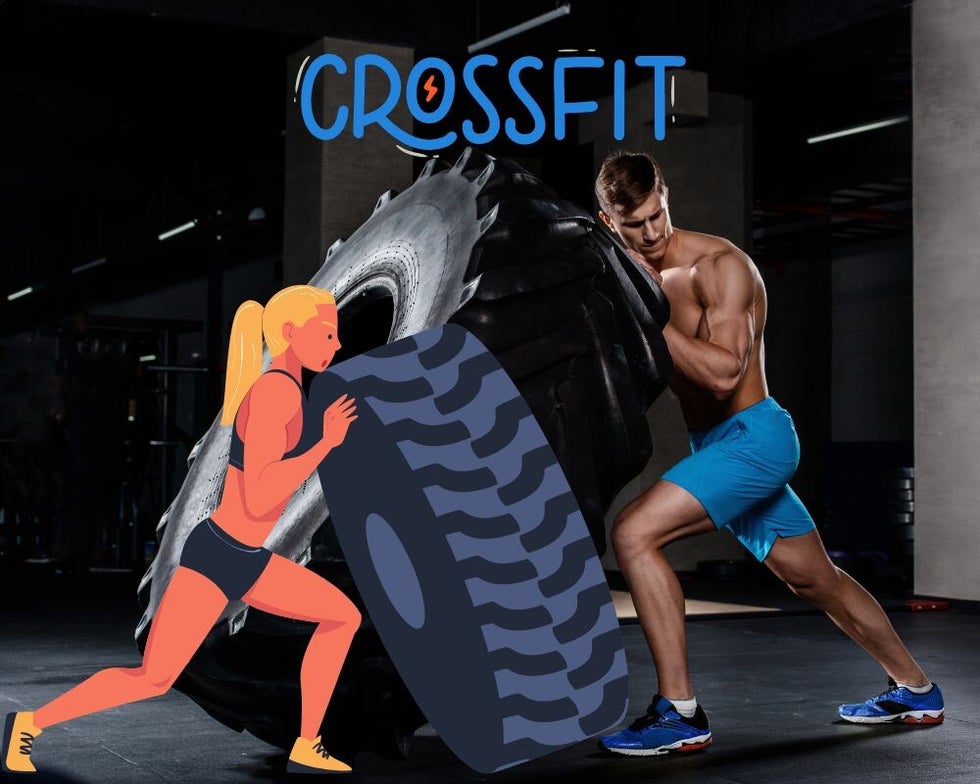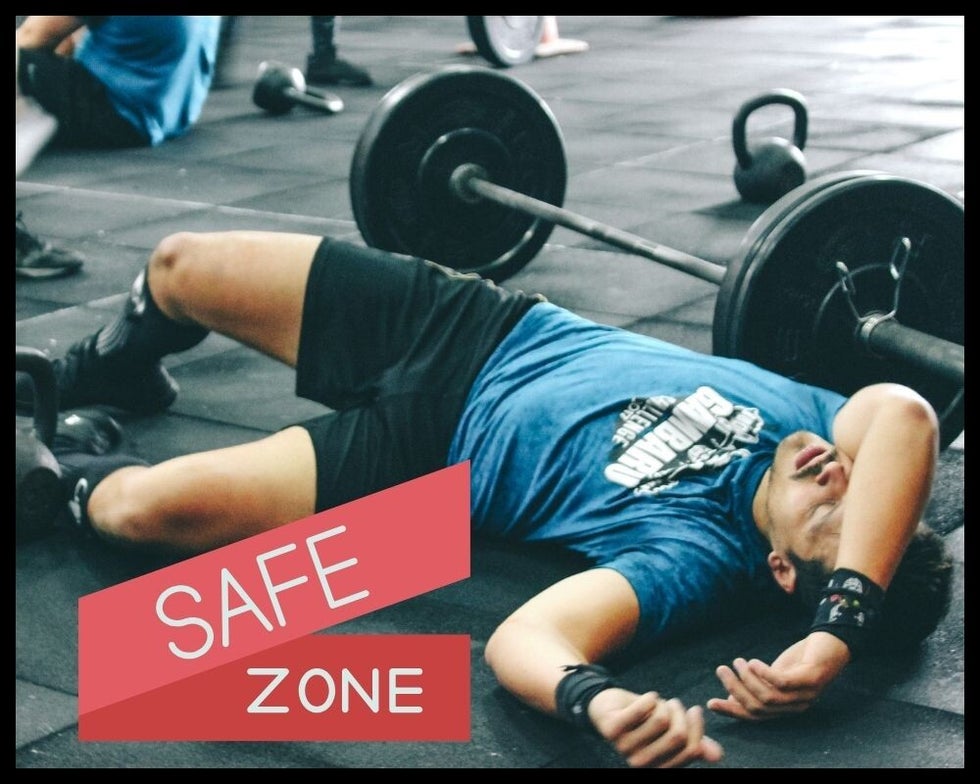When it comes to fitness trends, CrossFit has made quite a splash over the past decade. This high-intensity workout program is known for its blend of weightlifting, cardio, and gymnastics, all packed into a short, intense session.
But one of the most pressing questions people have is, can CrossFit help you lose weight? The answer isn’t as straightforward as you might think.

CrossFit isn't just another fitness fad; it’s a fitness program that promises to transform not just your body, but your mindset as well.
For many, the allure of CrossFit lies in its community-driven approach and the promise of rapid results. But with all the hype surrounding it, does CrossFit truly live up to its reputation as a weight loss powerhouse?
In this blog post, we’ll dive deep into the science behind CrossFit, explore who can benefit the most from it, and debunk some common misconceptions.
Whether you're a seasoned athlete or someone just starting their fitness journey, understanding how CrossFit works can help you make an informed decision about whether it's the right choice for your weight loss goals.
Let’s break down the hype and get to the truth.
What is CrossFit?
CrossFit is defined as a high-intensity fitness program that combines elements of various sports and types of exercise, such as weightlifting, running, rowing, and bodyweight movements.
It’s designed to improve overall fitness by targeting multiple domains: endurance, strength, flexibility, power, speed, coordination, agility, balance, and accuracy.
CrossFit workouts, known as WODs (Workout of the Day), are constantly varied, meaning no two workouts are the same.
This variety keeps the workouts engaging and challenges different muscle groups, which can be particularly effective for those looking to lose weight and build muscle.
Why has CrossFit gained popularity?
Since its inception in 2000 by Greg Glassman, CrossFit has exploded into a global phenomenon. One of the reasons for its popularity is its community aspect. CrossFit gyms, known as "boxes," foster a sense of camaraderie among participants.
This supportive environment can be incredibly motivating, particularly for those who may struggle to stay committed to traditional fitness programs.
Another key factor is the promise of results. CrossFit is known for delivering quick, visible changes, which appeals to those who are eager to see progress in their fitness journey.
How does CrossFit differ from other fitness programs?
Unlike traditional gym workouts, which may involve isolated exercises targeting specific muscle groups, CrossFit emphasizes functional movements that mimic everyday activities.
For example, a WOD might include squats, deadlifts, and kettlebell swings, all of which engage multiple muscle groups simultaneously.
This approach not only improves strength and endurance but also burns more calories in less time. This is particularly beneficial for weight loss, as it allows for a more efficient workout that continues to burn calories even after the session is over.

Can CrossFit Help You Lose Weight?
Weight loss is a common goal for many people, but the journey is often fraught with challenges. From finding the right diet to sticking with an exercise routine, the path to shedding pounds can be overwhelming.
CrossFit is frequently touted as an effective solution, but it’s important to separate fact from fiction. The hype around CrossFit often stems from its intensity and the transformative stories shared by its community members.
However, the effectiveness of CrossFit for weight loss depends on various factors, including your current fitness level, consistency, and diet.
Understanding the science behind CrossFit can help you determine whether it’s the right approach for your weight loss goals. In the following sections, we’ll explore the mechanics of weight loss and how CrossFit fits into the equation.
The Science Behind CrossFit and Weight Loss
When discussing weight loss, it’s crucial to understand the fundamentals of how the body sheds fat. At its core, weight loss is about creating a caloric deficit—burning more calories than you consume.
While this concept sounds simple, the execution can be complex, especially when factoring in different types of exercise. This is where CrossFit’s unique approach to fitness comes into play.
How Does Weight Loss Work?
At the most basic level, weight loss occurs when you consume fewer calories than your body needs to maintain its current weight. This caloric deficit forces your body to tap into stored fat for energy, leading to fat loss over time.
However, not all calories are created equal, and not all exercises impact your metabolism in the same way. For instance, cardio exercises like running or cycling primarily burn calories during the activity itself.
In contrast, resistance training—such as weightlifting—can continue to burn calories even after the workout is over. This phenomenon is known as the afterburn effect or Excess Post-Exercise Oxygen Consumption (EPOC).
What Makes CrossFit Effective for Weight Loss?
- High-Intensity Interval Training (HIIT):
CrossFit workouts often incorporate elements of HIIT, which involves short bursts of intense activity followed by brief periods of rest or lower-intensity exercise. HIIT is particularly effective for weight loss because it maximizes calorie burn in a short amount of time. Studies have shown that HIIT can burn up to 30% more calories than other forms of exercise, making it an efficient way to lose weight. - Muscle Building and Fat Loss:
One of the key benefits of CrossFit is its emphasis on building lean muscle mass. Muscle is more metabolically active than fat, meaning it burns more calories even at rest. By increasing your muscle mass through CrossFit’s weightlifting and strength training exercises, you can boost your metabolism, making it easier to maintain a caloric deficit and lose weight.
- The Afterburn Effect (EPOC):
The afterburn effect is another significant advantage of CrossFit. After a high-intensity workout, your body continues to burn calories at an elevated rate as it works to return to its pre-exercise state. This can last anywhere from a few hours to over 24 hours, depending on the intensity and duration of the workout. The combination of HIIT and strength training in CrossFit makes it particularly effective at triggering the afterburn effect, leading to more calories burned overall.
Comparative Analysis: CrossFit vs. Traditional Cardio for Weight Loss
To illustrate the effectiveness of CrossFit for weight loss, let’s compare it to traditional cardio exercises like running:
| Workout Type | Calories Burned (per 30 mins) | Afterburn Effect | Muscle Building | Overall Weight Loss Potential |
|---|---|---|---|---|
| CrossFit (HIIT + Strength) | 400-600+ | High | Significant | High |
| Running (Steady-State Cardio) | 200-300 | Low | Minimal | Moderate |
| Workout Type | Calories Burned (per 30 mins) | Afterburn Effect | Muscle Building | Overall Weight Loss Potential |
As you can see, CrossFit’s combination of high-calorie burn, afterburn effect, and muscle-building potential gives it a distinct advantage over traditional cardio when it comes to weight loss.
The Truth Behind the Hype: Does CrossFit Work for Everyone?
CrossFit’s popularity has led many to believe that it’s a one-size-fits-all solution for weight loss, but the reality is more nuanced.
While CrossFit can be highly effective, its success largely depends on individual factors such as fitness level, consistency, and personal goals.
In this section, we’ll explore who can benefit the most from CrossFit and address some common misconceptions about this intense workout regimen.

Who Can Benefit Most from CrossFit?
-
Ideal Candidates for CrossFit:
- Fitness Enthusiasts Looking for a Challenge:
CrossFit is well-suited for individuals who are already active and looking to push their physical limits. The varied and high-intensity nature of the workouts can help seasoned athletes break through plateaus and achieve new levels of fitness. - Those Who Thrive in Group Settings:
One of CrossFit’s unique selling points is its community-driven environment. If you find motivation in working out alongside others and enjoy the camaraderie of group classes, CrossFit might be the perfect fit. The accountability and support from fellow CrossFitters can be a powerful motivator, particularly during tough workouts. - People Seeking Comprehensive Fitness:
CrossFit doesn’t just focus on one aspect of fitness—it aims to improve strength, endurance, flexibility, and more. If your goal is to become well-rounded in your fitness abilities, CrossFit offers a holistic approach that targets multiple fitness domains.
-
Fitness Level Considerations:
- Beginners vs. Advanced Athletes:
While CrossFit is often associated with elite athletes, it’s important to note that it can be scaled to suit beginners as well. Many CrossFit boxes offer introductory classes and modified workouts that allow newcomers to ease into the program. However, beginners should be mindful of their limits and prioritize proper form to avoid injury. - Customization for Individual Needs:
CrossFit’s scalability means that workouts can be tailored to meet individual fitness levels and goals. For example, if you’re new to weightlifting, you might start with lighter weights and fewer reps, gradually increasing intensity as your strength improves. This flexibility makes CrossFit accessible to a wide range of fitness levels, from beginners to advanced athletes.
The Realities of CrossFit: Not Just a Quick Fix
-
The Importance of Consistency:
- Showing Up Regularly Matters:
Like any fitness program, the key to success with CrossFit is consistency. CrossFit’s intensity can yield quick results, but maintaining those results requires regular attendance and commitment. It’s not enough to show up sporadically; to truly benefit from CrossFit, you need to make it a part of your routine. - Building Habits Over Time:
CrossFit is designed to be challenging, and it’s common to feel sore or fatigued after a tough WOD. However, the long-term benefits come from building habits and pushing through discomfort. Over time, regular CrossFitters often find that their endurance, strength, and overall fitness improve significantly.
-
Balancing Intensity and Recovery:
- Avoiding Burnout and Injury:
One of the potential downsides of CrossFit is the risk of burnout or injury, especially if you push yourself too hard too soon. CrossFit’s culture of intensity can sometimes lead participants to push beyond their limits, which can be counterproductive in the long run. It’s crucial to listen to your body and incorporate rest days to allow for recovery. - The Role of Recovery in Weight Loss:
Recovery is just as important as the workouts themselves. Adequate rest, proper nutrition, and techniques like stretching and foam rolling can help prevent injuries and keep you on track with your weight loss goals. Remember, it’s not just about how hard you train, but how well you recover that determines your progress.
-
Common Misconceptions:
- Myth: CrossFit is Only for the Extremely Fit:
While CrossFit is known for its intense workouts, it’s a myth that you need to be in peak physical condition to start. CrossFit is designed to be inclusive, and with the right modifications, it can be suitable for people of all fitness levels. Whether you’re a seasoned athlete or just beginning your fitness journey, CrossFit can be adapted to meet you where you are. - Myth: CrossFit Alone Will Make You Lose Weight:
Another common misconception is that simply doing CrossFit will automatically lead to weight loss. While CrossFit can be a powerful tool for shedding pounds, it’s not a magic bullet. Weight loss also depends on other factors, including your diet, sleep, stress levels, and overall lifestyle. Combining CrossFit with a balanced diet and healthy habits is key to achieving sustainable weight loss.
CrossFit in Comparison to Other Fitness Programs
When compared to other fitness programs, CrossFit’s unique combination of functional movements, high intensity, and community support sets it apart.
While traditional gym workouts often focus on isolated muscle groups, CrossFit’s emphasis on compound movements targets multiple muscle groups simultaneously, leading to greater calorie burn and improved overall fitness.
Moreover, the social aspect of CrossFit is a major differentiator. The sense of community and accountability found in CrossFit boxes can be a significant motivator, helping participants stay consistent and committed to their fitness goals.

The Benefits of CrossFit Beyond Weight Loss
While weight loss is often a primary goal for many who start CrossFit, the benefits of this fitness program extend far beyond just shedding pounds.
CrossFit offers a holistic approach to fitness that can lead to significant improvements in overall health, mental well-being, and physical capabilities.
In this section, we’ll explore some of the key advantages of CrossFit that make it more than just a weight loss tool.
-
Building Strength and Confidence
1.1 Gaining Muscle, Losing Fat: The Dual Benefits of CrossFit
One of the standout features of CrossFit is its ability to build lean muscle mass while simultaneously reducing body fat.
Unlike traditional cardio workouts that primarily burn calories during the activity, CrossFit’s combination of strength training and high-intensity exercises promotes both muscle growth and fat loss.
This dual approach not only helps you lose weight but also improves your body composition, making you leaner and stronger.
Building muscle has additional benefits beyond aesthetics. Increased muscle mass boosts your metabolism, allowing you to burn more calories even at rest.
This metabolic boost is particularly beneficial for maintaining weight loss over the long term.
Moreover, the strength gains achieved through CrossFit can improve your performance in other physical activities, making everyday tasks easier and reducing the risk of injury.
1.2 Mental Toughness: How CrossFit Challenges Both Body and Mind
CrossFit isn’t just about physical strength—it also builds mental resilience. The challenging nature of CrossFit workouts pushes you to confront your limits and develop a growth mindset.
Overcoming tough workouts can build confidence and a sense of accomplishment, which often carries over into other areas of life.
Moreover, CrossFit’s emphasis on setting and achieving goals can foster a sense of discipline and determination.
Whether it’s lifting a heavier weight, completing a workout faster, or mastering a new skill, the continuous progress in CrossFit can boost your self-esteem and mental toughness.
This mental strength is invaluable, not just in fitness but in facing life’s challenges with greater resilience.
-
Community and Support: The CrossFit Culture
2.1 Finding Your Tribe: How the CrossFit Community Can Be Your Greatest Motivator
One of the most unique and powerful aspects of CrossFit is its community-driven culture.
Unlike traditional gyms where you might work out alone, CrossFit classes are designed to foster a sense of camaraderie and support.
This sense of community can be incredibly motivating, especially when you’re struggling to stay consistent or push through a tough workout.
In a CrossFit box, you’re not just another member—you’re part of a team.
The encouragement from coaches and fellow CrossFitters can help you stay committed to your fitness goals, even on days when you feel like giving up.
This social support system is a key factor in why many people stick with CrossFit longer than other fitness programs.
2.2 Accountability Partners: How Working Out with Others Helps You Stay on Track
Accountability is a crucial element of successful weight loss and fitness journeys. In CrossFit, the group setting naturally creates a system of accountability partners.
Whether it’s the coach pushing you to complete that last rep or a workout buddy encouraging you to show up for a 6 AM class, the collective effort in a CrossFit box helps keep you on track.
-
Holistic Health: How CrossFit Impacts Overall Well-being
3.1 Cardiovascular Health: Improving Your Heart Health Through High-Intensity Workouts
CrossFit’s high-intensity workouts are not just effective for weight loss—they’re also excellent for improving cardiovascular health. The combination of aerobic and anaerobic exercises in CrossFit can help lower blood pressure, improve cholesterol levels, and increase overall heart health.
Engaging in high-intensity exercise like CrossFit can significantly reduce the risk of heart disease, stroke, and other cardiovascular conditions. This is particularly important for those looking to improve their overall health, not just lose weight.
3.2 Flexibility and Mobility: Why Functional Movements in CrossFit Are Key to Long-Term Health
Another significant benefit of CrossFit is the emphasis on functional movements—exercises that mimic real-life activities and improve mobility.
Unlike machines at a traditional gym that isolate muscles, CrossFit movements involve multiple joints and muscle groups, which can enhance flexibility and range of motion.
Improved mobility is crucial for long-term health as it reduces the risk of injuries, particularly as you age.
For example, exercises like squats, lunges, and kettlebell swings in CrossFit can improve hip mobility, strengthen the core, and promote better posture.
These functional movements make daily activities like lifting groceries, climbing stairs, or even playing with your kids easier and safer.

-
The Mental Health Benefits of CrossFit
4.1 Reducing Stress and Anxiety
Physical exercise is well-known for its ability to reduce stress and anxiety, and CrossFit is no exception. The intense nature of CrossFit workouts can lead to the release of endorphins, which are natural mood lifters.
This endorphin boost can help alleviate feelings of stress and anxiety, making you feel more relaxed and happier after a workout.
Moreover, the focus required during CrossFit workouts can serve as a form of mindfulness, helping you stay present and distract you from worries or negative thoughts.
The combination of physical exertion and mental focus can create a powerful stress-relieving effect that lasts long after the workout is over.
4.2 Boosting Self-Esteem and Mental Resilience
CrossFit’s goal-oriented approach can also boost self-esteem. Achieving new personal records (PRs), mastering complex movements, or simply completing a challenging WOD can give you a sense of accomplishment and pride.
This sense of achievement can translate into greater confidence in other areas of your life, helping you tackle challenges with a positive mindset.
In addition, the mental resilience developed through CrossFit—pushing through tough workouts, overcoming setbacks, and continuously striving for improvement—can enhance your ability to cope with stress and adversity in daily life.
Challenges and Risks: What to Consider Before Starting CrossFit
While CrossFit offers a multitude of benefits, it’s important to approach this intense fitness program with a clear understanding of the potential challenges and risks.
Knowing what to expect can help you make informed decisions and set realistic goals, ensuring that your CrossFit experience is both safe and effective.
-
Is CrossFit Right for You?
1.1 Assessing Your Fitness Level: How to Determine if CrossFit is a Good Fit
Before diving into CrossFit, it’s essential to evaluate your current fitness level. CrossFit workouts are known for their intensity, and while they can be scaled to accommodate beginners, it’s important to understand your own limitations.
If you’re new to exercise or haven’t been active for a while, starting with a less intense program might be a better option before transitioning to CrossFit.
- Fitness Assessment: Consider getting a fitness assessment from a certified trainer to gauge your strength, endurance, and mobility. This can help you understand which areas need improvement and whether CrossFit is the right starting point for you.
- Beginner-Friendly Options: Many CrossFit boxes offer introductory or “On-Ramp” programs designed specifically for beginners. These programs focus on teaching the fundamentals of CrossFit movements and building a solid fitness foundation before advancing to more intense workouts.
1.2 Identifying Personal Goals: What Do You Want to Achieve?
Understanding your personal fitness goals is crucial when deciding whether CrossFit is right for you. CrossFit is highly effective for building strength, improving cardiovascular fitness, and losing weight, but it’s not the only option available.
Consider what you want to achieve and whether CrossFit aligns with those objectives.
- Weight Loss: If weight loss is your primary goal, CrossFit can be an excellent choice due to its combination of strength training and high-intensity cardio. However, pairing CrossFit with a balanced diet and proper recovery is essential for achieving and maintaining weight loss.
- Strength and Conditioning: CrossFit is ideal for those looking to build muscle and increase overall strength. The varied workouts keep your muscles challenged, which can lead to significant strength gains over time.
- Community and Motivation: If you thrive in group settings and need external motivation to stay consistent, the community aspect of CrossFit can be a major advantage. The support from coaches and fellow participants can help you stay committed to your goals.
-
The Importance of Proper Form and Technique
2.1 Injury Risks: Common Injuries in CrossFit and How to Avoid Them
One of the main criticisms of CrossFit is the potential for injury, particularly if exercises are performed with improper form or too much intensity. Common CrossFit injuries include:
- Shoulder Injuries: Due to the high volume of overhead movements like presses and pull-ups, shoulder injuries are relatively common in CrossFit. Ensuring proper shoulder mobility and using correct form are key to preventing these injuries.
- Lower Back Strain: Movements like deadlifts and kettlebell swings can place a significant load on the lower back. To avoid strain, focus on maintaining a neutral spine and engaging your core during these exercises.
- Knee Pain: Squats and lunges are staples in CrossFit, but if performed incorrectly, they can lead to knee pain or injury. Proper alignment and avoiding excessive weight are crucial for knee safety.
How to Avoid Injuries:
- Start with Lighter Weights: Especially as a beginner, it’s important to prioritize technique over heavy weights. Starting with lighter weights allows you to perfect your form and reduce the risk of injury.
- Warm-Up and Cool Down: Proper warm-up and cool-down routines are essential for preventing injuries. A good warm-up should include dynamic stretches and movements that mimic the exercises you’ll be doing in the workout. Cool down with static stretches to improve flexibility and promote recovery.
- Listen to Your Body: It’s important to listen to your body and recognize the difference between discomfort and pain. Discomfort is normal during intense workouts, but sharp or persistent pain is a sign to stop and reassess your form or intensity.
2.2 The Role of Coaches: How Proper Guidance Can Prevent Injuries
CrossFit coaches play a critical role in ensuring that participants perform exercises safely and effectively. A good coach will provide clear instructions, correct your form, and offer modifications when necessary.
Here’s what to look for in a CrossFit coach:
- Qualifications and Experience: Ensure that your coach is certified and has experience working with participants of varying fitness levels. Ask about their background and how they approach injury prevention.
- Attention to Detail: A good coach will pay close attention to your form during exercises and offer immediate feedback. They should also be able to modify workouts to suit your individual needs and limitations.
- Supportive Environment: The best CrossFit coaches foster a supportive and encouraging environment, where you feel comfortable asking questions and expressing concerns.

-
Cost Considerations: Is the Investment Worth It?
CrossFit memberships can be more expensive than traditional gym memberships, which is an important factor to consider.
The higher cost often reflects the smaller class sizes, personalized coaching, and the specialized equipment used in CrossFit. Here’s how to determine if the investment is worth it:
- Evaluate the Value: Consider the quality of coaching, the sense of community, and the results you’re likely to achieve. If these aspects align with your fitness goals, the higher cost may be justified.
- Compare Options: Some CrossFit boxes offer different membership tiers or class packages that might better fit your budget. Additionally, consider the cost of other fitness programs you might need if you opt not to do CrossFit—such as hiring a personal trainer, which can also be costly.
- Trial Classes: Many CrossFit gyms offer free or discounted trial classes. Take advantage of these offers to see if CrossFit is a good fit for you before committing to a membership.
-
How to Get Started with CrossFit Safely
4.1 Finding the Right Box: Tips for Choosing a CrossFit Gym
Choosing the right CrossFit gym (or “box”) is crucial for your success and safety. Here are some tips for finding the right fit:
- Research Online: Start by researching CrossFit boxes in your area. Look for reviews and testimonials from current and former members to get a sense of the gym’s reputation.
- Visit in Person: If possible, visit the box in person to observe a class. Pay attention to the coaching style, the cleanliness of the facility, and the overall atmosphere.
- Ask Questions: Don’t be afraid to ask questions about the coaches’ qualifications, the class structure, and how the gym tailor’s workouts to different fitness levels.
4.2 What to Expect in Your First CrossFit Class
Your first CrossFit class can be both exciting and intimidating. Here’s what you can expect:
- Introduction to Basic Movements: Most first classes will start with an introduction to the fundamental CrossFit movements, such as squats, deadlifts, and presses. This is to ensure you understand the correct form before attempting more complex exercises.
- Scalable Workouts: Expect the workout to be challenging but remember that all exercises can be scaled to match your fitness level. Your coach will provide modifications if needed.
- Community Support: One of the best parts of your first CrossFit experience is the support from the community. Fellow CrossFitters are often eager to help newcomers, offering encouragement and advice.
4.3 Safety First: The Importance of Proper Form and Scaling Workouts
To get the most out of CrossFit while minimizing risk, focus on the following safety tips:
- Form Over Speed: It’s easy to get caught up in the competitive atmosphere of CrossFit, but always prioritize form over speed or weight. Proper form reduces the risk of injury and ensures you’re targeting the correct muscle groups.
- Listen to Your Coach: Your coach is there to guide you—take their advice seriously, especially when it comes to scaling workouts. If a movement feels too challenging or painful, don’t hesitate to modify it.
- Pace Yourself: It’s okay to take breaks and pace yourself, especially when you’re just starting. CrossFit is about progress, not perfection, so focus on building a solid foundation before pushing your limits.
Can CrossFit Help You Lose Weight? Key Takeaways
After exploring the various aspects of CrossFit and its impact on weight loss, it’s clear that this fitness program offers a powerful and holistic approach to improving overall health and fitness.
However, the effectiveness of CrossFit for weight loss depends on several factors, including your consistency, diet, and commitment to the process.
In this final section, we’ll summarize the key takeaways and provide some final thoughts on whether CrossFit is the right choice for you.
-
-
The Bottom Line: CrossFit and Weight Loss
1.1 Why CrossFit Can Be Effective for Weight Loss
- High-Calorie Burn: CrossFit’s combination of high-intensity interval training (HIIT) and strength exercises leads to a significant calorie burn both during and after workouts. The afterburn effect, or EPOC, ensures that your body continues to burn calories long after the workout is over.
- Muscle Building: Building lean muscle mass through CrossFit not only enhances your strength and endurance but also boosts your metabolism. A higher metabolic rate helps you burn more calories at rest, making it easier to maintain a caloric deficit and lose weight.
- Variety and Motivation: The constantly varied workouts in CrossFit keep your body guessing, which can prevent plateaus and keep you motivated. The community support and accountability inherent in CrossFit can also help you stay on track with your fitness goals.
1.2 The Importance of a Balanced Approach
While CrossFit is a highly effective tool for weight loss, it’s important to remember that it’s just one piece of the puzzle. Achieving sustainable weight loss requires a balanced approach that includes:
- Proper Nutrition: A healthy, balanced diet is crucial for weight loss. Focus on whole foods, lean proteins, and plenty of fruits and vegetables. Ensure you’re consuming enough calories to fuel your workouts while maintaining a caloric deficit.
- Recovery and Rest: Adequate rest and recovery are essential for preventing burnout and injury. Listen to your body and incorporate rest days, stretching, and other recovery techniques into your routine.
- Consistency: Consistency is key to seeing results with CrossFit. Regular attendance and commitment to your workouts will yield the best results over time.
-

-
Final Thoughts: Is CrossFit the Right Choice for You?
2.1 Weighing the Pros and Cons
Deciding whether CrossFit is the right fit for your weight loss journey requires weighing the pros and cons:
- Pros:
- Highly effective for burning calories and building muscle.
- Varied workouts keep you engaged and motivated.
- Strong community support and accountability.
- Scalable to different fitness levels.
- Cons:
- Potential for injury if proper form is not maintained.
- High intensity may not be suitable for everyone, especially beginners.
- Cost of membership can be higher than traditional gyms.
Ultimately, the decision to pursue CrossFit should align with your personal goals, fitness level, and preferences. If you enjoy high-intensity, varied workouts and thrive in a supportive community environment, CrossFit could be an excellent choice for achieving your weight loss and fitness goals.
2.2 Encouragement: Your Weight Loss Journey is Unique
Remember that your weight loss journey is unique to you. There’s no one-size-fits-all approach to fitness, and what works for one person might not work for another.
Whether you choose CrossFit, another form of exercise, or a combination of different activities, the most important thing is to stay committed, listen to your body, and celebrate your progress along the way.
Every small victory—whether it’s lifting a heavier weight, completing a workout faster, or simply feeling more confident—is a step toward your ultimate goal. Stay motivated, stay consistent, and remember that the journey is just as important as the destination.
Take Your First Step Towards a Healthier You
If you’re ready to start your CrossFit journey and explore whether it can help you achieve your weight loss goals.
Explore more comprehensive articles, guides, and resources on fitness, nutrition, and healthy living on my website. Whether you’re new to CrossFit or a seasoned athlete, you’ll find valuable information to help you succeed.
Purple tea trick melts 2lbs daily
I'm sure you've been told to start drinking green tea if you want to drop a few pounds, however…
It just doesn't work.
You have to drink like 10 cups a day just to notice a tiny difference.
The good news is…
There's a new type of "purple tea" that burns fat like crazy and melts up to 2lbs a day.
Here it is:
Purple Tea Trick Melts Up To 2lbs Daily
Over 22,877 people have tried it so far with some amazing results…
Like dropping 2 jean sizes in the first week, so…
Give it a shot now before it becomes too mainstream.









Add comment
Comments